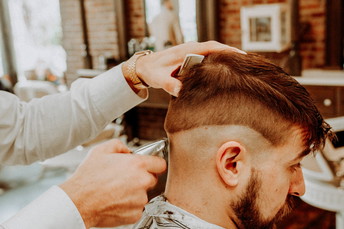How to Give Yourself a Crew Cut with Clippers
Before we begin, remember that having the right tools for the job matters.
Note:
Even the easiest haircuts can get complicated a frustrating if you have inefficient tools.
Anyway:
Assuming that you have all the necessary tools, let’s jump in and look at ways of doing a DIY Crew Cut.
Find an Image Reference
Fun fact:
Images serve as blueprints for any kind of hairstyle.

For new barbers and DIY fans, having an image of the haircut you want will come in handy.
Take time to study the photo in order to plan how you are going to go about doing a crew cut haircut on yourself.
Clipping the Sides and Back
Start by doing a fade on your sides and back.
Now:
Depending on the look you are aiming for, you have the option of doing a taper-fade down to a skin fade.
Another thing you need to know about fade is that it comes in different variations.
It can either be:
- A High Fade: Starts around the temples.
- A Low Fade: Starts a bit closer to the nape.
- Or a Mid Fade: Begins mid-way between the ears and the temples.
Note:
A fade line refers to where the hair transitions from one length to another.
Pro Tip:
Always your clipper up and out when doing a fade. That will leave your sides looking neat and evenly trimmed.
Learn more about fading in this in-depth guide on how to cut proper fades.
Cut and Style Your Top Hairs
There isn’t much to do here.
If you are aiming for a standard Crew Cut, remember to keep the top hair short and sides/back shorter.
On the other hand, if you intend on styling your tops part, you can leave it long – up to 3 inches long.
Final Touches and Blending
Note:
Blending is simply the process of smoothening out layers of differently sized hair to create a smooth transition from layer to layer.
Basically, this is where you perfect your sides and back to give them a smooth fading effect.
Now:
Blending isn’t so hard; what you do is find a guard or blade size that’s between the sizes of the two adjacent layers.
For example:
If Layer1 is a #0 and Layer2 is a #1, you should use a #0.5 to do the blending.
Yes! It’s that easy.
And finally, you can do a nice hairline design – if need be – to give your haircut a sharp, stylish, and professional-looking finish.
Frequently Asked Questions
More from Mike Medders

How to Talk to Barbers Like a Pro: Insights from Expert Barbers

Trust me, I've been on both sides of the chair. I can't count the number of times a client has sat down and struggled…

Slick Back Haircut

Barber Spotlight: Slick Back Haircut Transformation by Nat The slick back haircut is a timeless classic, combining…


Comments